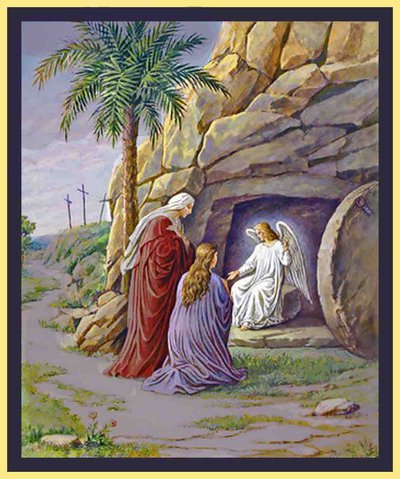Thoughts for the Day
Monday, 21st April 2025: Rejoice!
Easter Matthew 28 Mary Magdalene Angel Resurrection Rejoice Jesus
Reading : Verses from Matthew, Chapter 28

After the sabbath, as the first day of the week was dawning, Mary Magdalene and the other Mary went to see the tomb. And suddenly there was a great earthquake; for an angel of the Lord, descending from heaven, came and rolled back the stone and sat on it. His appearance was like lightning, and his clothing white as snow. For fear of him the guards shook and became like dead men. But the angel said to the women, ‘Do not be afraid; I know that you are looking for Jesus who was crucified. He is not here; for he has been raised, as he said. Come, see the place where he lay. Then go quickly and tell his disciples, “He has been raised from the dead!" ...
So they left the tomb quickly with fear and great joy, and ran to tell his disciples. Suddenly Jesus met them and said, ‘Greetings!’ And they came to him, took hold of his feet, and worshipped him. Then Jesus said to them, ‘Do not be afraid; go and tell my brothers to go to Galilee; there they will see me.’
While they were going, some of the guard went into the city and told the chief priests everything that had happened. After the priests had assembled with the elders, they devised a plan to give a large sum of money to the soldiers, telling them, ‘You must say, “His disciples came by night and stole him away while we were asleep.” If this comes to the governor’s ears, we will satisfy him and keep you out of trouble.’ So they took the money and did as they were directed. And this story is still told among the Jews to this day.
(Lectionary, New Revised Standard Version)
Thoughts
Matthew's Gospel records the event of the resurrection slightly differently to John's Gospel, as we might expect when the latter was writing years later and recording different witness accounts. Matthew has two Mary's going to the tomb after the Passover festival has been held, on the first day of the week, where they meet an angel, and then Jesus appears.
In our New Revised Standard version of the Bible Jesus says the word "Greetings!" to the two women. Other translations say "Hello!" or "All hail!". However, if we look at the Greek root for this word, "χαίρω" (chairó), this primarily means "Rejoice", and is often used in the New Testament when meeting someone, or when referring to God's grace and goodness.
As well as bidding the women to "Rejoice" though, Jesus gives reiterates what the angel has said. They are not to be afraid. In other words, are "to believe" that what they are experiencing is the truth. After all the empty tomb, the abandoned grave clothes, the angel, and then the appearance of Jesus, all prove this.
Lastly they are to "Go and tell" the disciples to go to Galilee, and in doing so to explain all that has happened to the women, including that they have met the risen Lord.
These three instructions should be important for us today: "Rejoice! Belief in the Resurrection! Go and tell others!"
Prayer
Lord Jesus Christ,
may we never forget the sacrifice
that You made for us;
that You suffered a cruel death,
to free us from our sin;
and so reunite us with Your Father.
May we rejoice in the good news
of Your resurrection,
accepting it was a gift of grace,
and seek to share our faith with others.
Amen.
If you would like to more think about the account of the guards, this is interesting: